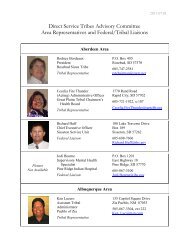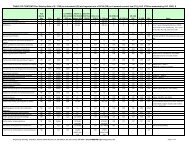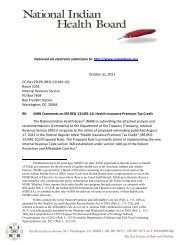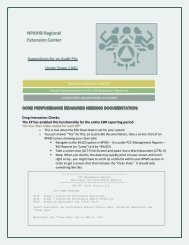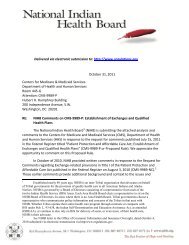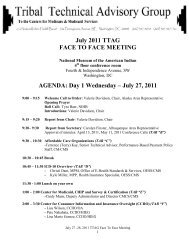mmpc - National Indian Health Board
mmpc - National Indian Health Board
mmpc - National Indian Health Board
You also want an ePaper? Increase the reach of your titles
YUMPU automatically turns print PDFs into web optimized ePapers that Google loves.
v.7, 2012‐09‐23a<br />
(1) to ensure the highest possible health status for <strong>Indian</strong>s and urban <strong>Indian</strong>s and<br />
to provide all resources necessary to effect that policy;<br />
(2) to raise the health status of <strong>Indian</strong>s and urban <strong>Indian</strong>s to at least the levels set<br />
forth in the goals contained within the <strong>Health</strong>y People 2010 initiative or<br />
successor objectives;<br />
(3) to ensure maximum <strong>Indian</strong> participation in the direction of health care<br />
services so as to render the persons administering such services and the services<br />
themselves more responsive to the needs and desires of <strong>Indian</strong> communities;<br />
(4) to increase the proportion of all degrees in the health professions awarded to<br />
<strong>Indian</strong>s so that the proportion of <strong>Indian</strong> health professionals in each Service area<br />
is raised to at least the level of that of the general population;<br />
(5) to require that all actions under this Act shall be carried out with active and<br />
meaningful consultation with <strong>Indian</strong> tribes and tribal organizations, and<br />
conference with urban <strong>Indian</strong> organizations, to implement this Act and the<br />
national policy of <strong>Indian</strong> self-determination;<br />
(6) to ensure that the United States and <strong>Indian</strong> tribes work in a government-togovernment<br />
relationship to ensure quality health care for all tribal members; and<br />
(7) to provide funding for programs and facilities operated by <strong>Indian</strong> tribes and<br />
tribal organizations in amounts that are not less than the amounts provided to<br />
programs and facilities operated directly by the Service.<br />
4<br />
The Patient Protection and Affordable Care Act (Pub. L. 111-148) as amended by the <strong>Health</strong> Care and Education<br />
Reconciliation Act of 2010 (Pub. L. 111-152), are collectively referred to herein as the “Affordable Care Act” or<br />
“ACA”.<br />
5<br />
<strong>Health</strong> insurance exchanges (“Exchanges”) are to be available by October 1, 2013 in each State in order to allow<br />
enrollment in new health insurance coverage options effective January 1, 2014. Exchanges are marketplaces for the<br />
offering of health insurance coverage, mechanisms for determining eligibility for various government health<br />
insurance programs, and vehicles for securing government assistance, if eligible, with covering all or a portion of the<br />
health insurance plan monthly premiums.<br />
6<br />
ACA § 1501(b) / IRC § 5000A(e)(3).<br />
7<br />
See Federal Register, March 27, 2012, CMS, “Patient Protection and Affordable Care Act; Establishment of<br />
Exchanges and Qualified <strong>Health</strong> Plans,” (CMS-9989-F), Vol. 77, No. 59, page 18346. (“Final Rule”) The<br />
Department of <strong>Health</strong> and Human Services (HHS) and CMS did not opine on the definition of <strong>Indian</strong> pertaining to<br />
the exemption from tax penalties afforded AI/ANs under ACA § 1501(b) as it falls within the Internal Revenue<br />
Code. (See IRC § 5000A(e)(3).) CMS did determine that the two Exchange-related definitions (contained in the<br />
IHCIA and the <strong>Indian</strong> Self-Determination and Education Assistance Act) “operationally mean the same thing.”<br />
8<br />
The position that these definitions are effectively and operationally the same is also held by numerous tribes and<br />
tribal organizations, including the <strong>National</strong> Congress of American <strong>Indian</strong>s (“NCAI”), the <strong>National</strong> <strong>Indian</strong> <strong>Health</strong><br />
<strong>Board</strong> (“NIHB”), the Tribal Technical Advisory Group to CMS (“TTAG”), the Tribal Self-Governance Advisory<br />
Committee (“TSGAC”), and the Northwest Portland Area <strong>Indian</strong> <strong>Health</strong> <strong>Board</strong> (NPAIHB”), among others.<br />
9<br />
In a meeting of the Medicare, Medicaid and <strong>Health</strong> Reform Policy Committee of the <strong>National</strong> <strong>Indian</strong> <strong>Health</strong> <strong>Board</strong><br />
on February 21, 2012, IRS representatives indicated that the IRS likely would defer to the uniform determination<br />
made by an Exchange as to who is “<strong>Indian</strong>” and as such qualifies for an exemption from tax penalties under the<br />
ACA.<br />
10<br />
These cost-sharing protections for AI/ANs include those established under § 5006 of the American Reinvestment<br />
and Recovery Act of 2009, Pub. L. 111-5 and those enacted as part of the Balanced Budget Act of 1997 (Social<br />
Security Act § 1932(a)(2)(C).)<br />
11<br />
See 42 C.F.R. § 447.50, promulgated May 28, 2010. In particular, these regulations drew from the definitions of<br />
<strong>Indian</strong> in the Snyder Act, the IHCIA, and the <strong>Indian</strong> Self-Determination and Education Assistance Act<br />
(“ISDEAA”). A second set of <strong>Indian</strong>-specific Medicaid protections was enacted in the Balanced Budget Act of<br />
Northwest Portland Area <strong>Indian</strong> <strong>Health</strong> <strong>Board</strong> Page 13 of 16




